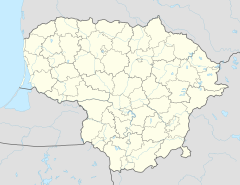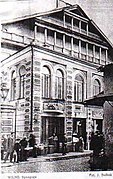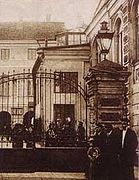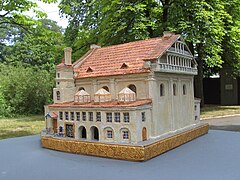Great Synagogue of Vilna
| Great Synagogue of Vilnius | |
|---|---|
Vilnius' Old Town, Lithuania | |
| Geographic coordinates | 54°40′48″N 25°17′05″E / 54.68000°N 25.28472°E |
| Architecture | |
| Style | Renaissance-Baroque |
| Completed | 1572. Rebuilt 1633. |
| Demolished | 1955–1957 |
| Capacity | 5,000 |
The Great Synagogue of Vilnius, which once stood at the end of Jewish Street (I-2), Vilnius, Lithuania, was built between 1630 and 1633 after permission was granted to construct a synagogue from stone. Standing on the spot of an existing synagogue built in 1572, the site had first been used to house a Jewish house of prayer in 1440. Damaged in World War II, it was demolished in 1955–1957 and replaced by a kindergarten and a primary school.
Structure
The synagogue had a number of entrances. One, at street level, consisted of a pair of iron gates that had been donated by a tailors' society in 1640. The other entrance on the western side, added in 1800, was a bit more imposing: it had an elevated two-tiered wooden
The interior of the synagogue was redesigned in the mid-18th century by

The two-tiered Holy Ark on the eastern wall was carved with gilded woodcarvings, representing plants, animals and Jewish symbols, with a double-headed eagle on top. It was approached by a twofold flight of steps, with iron balustrades, ascending from the right and the left. Hanging from the walls and ceilings there were numerous bronze and silver chandeliers.[1] The synagogue contained a valuable collection of ritual objects. The building was repaired in the 19th century.
Formerly there was a seven-branched brass
On both sides of the Holy Ark there were two-story structures, serving as the women's sections, connected to the prayer hall by little windows. Another gallery for women was situated along the north side, also consisting of two floors built by Noah Feibusch Bloch, a community elder who advanced the money and when the community was unable to return the 14,000 gulden due, he made a present of the structure.
The main prayer hall was square and could hold 300 people. The synagogue was also intended to serve as a stronghold within which the Jews could take refuge in times of danger. On the High Holy Days before World War II the synagogue held 5,000 worshipers.
In 1846, when Sir Moses Montefiore visited the synagogue, the treasurers distributed entrance tickets to the masses of people.
Destruction

The synagogue was looted, burned and partly destroyed by the Nazis during World War II. The ruined synagogue and the whole "schulhof" complex that had grown around it were demolished by the Soviet authorities from 1955 to 1957 and were intentionally replaced by a basketball court and a kindergarten to effectively prevent any future initiatives to rebuild a cultural monument. The kindergarten was later replaced by a primary school.
Three original pieces from the Great Synagogue of Vilna survived the destruction and are now on display at the Vilna Gaon Jewish Museum: a door of the Holy Ark, a reader’s desk, and a bas-relief with the Ten Commandments.
Plans of restoration
In 2011, Lithuanian Prime Minister
The original walls of the Great Synagogue were pinpointed by a team of archaeologists from the Israel Antiquities Authority, the Hebrew University of Jerusalem, and three American universities[4] using ground-penetrating radar in June 2015 beneath the grounds of modern school building.[5] Excavations began in 2016, when a group led by Dr. Harry Gol of the American University of Wisconsin–Eau Claire excavated what is thought to be a portion of the synagogue's mikveh.[6][7] In July 2018, the archaeologists announced the discovery of the Baroque bimah. Vilnius Mayor Remigijus Šimašius said that the plans were to demolish the Soviet-built premises, since the primary school had moved out in 2017, and replace it with a meaningful memorial and exposition of the ruins, but not a complete reconstruction of the synagogue, to be completed by 2023.[8]
In 2019 archaeologists uncovered Hebrew inscription at the excavation of the Great Synagogue in Vilna. The large and significant inscription, dated to 1796, was part of a stone Torah reading table that stood on the magnificent Bimah of the synagogue in Vilnius. The table was donated – according to the text – by two brothers – Rabbi Eliezer and Rabbi Shmuel, in memory of their mother, Sarah, and their father, Rabbi Chaim, who, according to the inscription, had emigrated from Lithuania to Eretz Israel and settled in Tiberias. It was from this table that the Torah was read to the congregants for about 200 years, until the burning of the synagogue and its final destruction by the Soviets, 70 years ago. The inscription, which was studied together with Dr. Vladimir Levin of the Hebrew University of Jerusalem, reads this: "In the year ‘Raise us with joy to our country’ [=1796], [This Torah reading table] was donated by R. Eliezer and R. Shmuel, the sons of R. Chaim who lived in Tiberias, be it rebuilt and reestablished soon in our days. ‘And died Sarah’ [Gen. 23:2] our mother, the daughter of R. Shabbtai, on the 4th of Adar ‘I gave to Jerusalem a messenger of good news’ [Is. 41:27] [=1782] and our father R. Chaim son of R. Chaim died there on the 7th of Nissan ‘arise and have mercy on Zion [Ps. 102:14] [=1786]." These brief sentences point to the deep connection between the Lithuanian (Litvak) community and the Holy Land, which has existed since the days of the
Haim tombstone writing: M’K [mekom kevurat/matzevat kevruat] [place of burial/ tombstone of burial] The excellent Ha[cham] [Clever] KeHaR [Kevod Harav] [His honorable Rabbi] = Haim Ashkenazi
Haim immigrated to Eretz Israel with his wife Sarah in 1770 or 1772, together with Rabbi Azriel of Shklow – the grandfather of Rabbi Yisroel of Shklov- of the HaGra Students immigration leaders, died and buried in the cemetery on Mount Olives in the holy city of Jerusalem. The text from the Vilna synagogue mentions the names of Rabbi Haim’s two sons of– Rabbi Shmuel and Rabbi Eliezer. They can be identified as the brothers Shmuel and Eliezer sons of Rabbi Haim Shabtls, the first “Vilna's
Gallery
-
Model of the Great Synagogue of Vilna at theDiaspora Museum, Tel Aviv
-
Postcard c.1920
-
Western flank
-
Eastern flank
-
Gate to the courtyard
-
Model of the Great Synagogue of Vilna, 2018
-
Model (interior) of the Great Synagogue of Vilna, 2018
See also
- History of the Jews in Poland
- Lithuanian Jews
- Vilna Gaon
References
- ^ "Hallelujah! Assemble, Pray, Study – Synagogues Past and Present". Beit Hatfutsot.
- ^ "Vilniaus Didžiosioji sinagoga bus atstatyta?". www.sekunde.lt.
- ^ "Peres invited to advise on restoration of Vilnius synagogue". www.timesofisrael.com.
- ^ Rogers, James (2015-08-07). "Radar technology helps rediscover the Great Synagogue of Vilnius, 70 years after its destruction". Fox News. Retrieved 2018-04-16.
- ^ Geggel, Laura (August 3, 2015). "Remains of Synagogue Destroyed by Nazis Found With Radar". NBC News. Retrieved August 4, 2015.
- ^ Grogan-Ripp, Lucy (17 Nov 2017). "Blugolds find closure for Holocaust victims". UWEC News. University of Wisconsin–Eau Claire. Retrieved 16 April 2018.
- Public Broadcasting Service. WGBH. Retrieved 16 April 2018.
- ^ Levickytė, Paulina (26 July 2018). "Šimašius: apie Didžiosios sinagogos atstatymą kalbos nėra" (in Lithuanian). ELTA via delfi.lt. Retrieved 26 July 2018.
- ^ "Archaeologists uncover Hebrew inscriptions at excavations of the Great Synagogoue in Vilnus ( Vilna)". Israel Ministry of foreign Affairs. 23 July 2019.
- ^ "Great Synagogue of Vilna, Ravaged by foes. Yields Treasures and a priceless Hebrew Inscription By Laura Geggel". LIVE SCIENCE. 23 July 2019.
External links
![]() Media related to Great Synagogue in Vilnius at Wikimedia Commons
Media related to Great Synagogue in Vilnius at Wikimedia Commons
- The Great City Synagogue of Vilna – The Museum of the Jewish People at Beit Hatfutsot
- Stanley Mann: The City That Could Not Be Vanquished
- The Great Synagogue in the Bezalel Narkiss Index of Jewish Art, The Center for Jewish Art, the Hebrew University of Jerusalem
- Arutz 7, “An Exciting Discovery in the Great Synagogue of Vilna” 23/07/19
- Lithuania’s ‘Great Synagogue’ Fell to the Nazis. but Archaeologists have Uncovered It by Tom Metcalfe, August 06.2018 LIVE SCIENCE website








